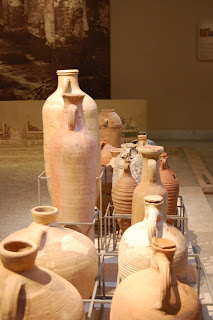Today was Greek Independence Day when the Greeks won independence from the Turks. Here is a little description of Greek Independence Day and also the meaning of the flag. The pictures are from the parade that went through town today! Each different outfit represents a different area in Greece or a Greek school that is near Thessaloniki.
Greek Independence Day
The celebration of Greek Independence Day on March 25th draws inspiration from one of the holiest days for Greek Orthodox Christians, the Annunciation of the Theotokos. This is the day that the Archangel Gabriel announced to Mary that she would bear a child. Bishop Germanos of Patras seized the opportunity by raising the banner of revolution, in an act of defiance against the Turks and marked the beginning of the War of Independence. Cries of Zito H Ellas and Eleftheria H Thanatos can still be heard today. These freedom fighters, or klephts as they were called, of Greece sacrificed much for their country. Kolokotronis, Nikitara, Karaiskakis, Bouboulina, and Mpotsaris are some of the heroes of the revolution.
The struggle for independence was supported abroad by intellectuals of the day. In addition to the Secret Society of Friends (Filiki Etaeria) and the Sacred Band (Ieros Lohos) prominent world figures including Lord Byron of England, Daniel Webster and Dr. Samuel Gridly Howe of the United States raised the interest level among Europeans and Americans.
After centuries of unsuccessful uprisings and failure of the Ottoman Empire to assimilate and convert the Greeks, The War of Independence began in 1821 rising up against 400 years of occupation and oppression by the Ottoman Turks. The origin of the Turkish occupancy began in 1453 with the fall of Constantinople (currently referred to as Istanbul). All true and faithful Hellenes living in their occupied homeland reacted to the Turkish oppression and resisted the attempts to deprive the Greeks of their heritage, their freedom and their religion. During the dark years of the Ottoman occupation, thousands were killed and tortured for attending church or teaching their children culture, history and language. It was the Greek Orthodox Church that helped to retain their very identity by the institution of Crypha Scholia (Hidden Schools).
For eight years the fighting ensued, until 1829, when the Sultan Mahmud II, facing Soviet troops at the gates of Constantinople, accepted Greek independence with the Treaty of Andrianople.


Pom-Pom Shoes! Very Festive - many of the guys in the parade had them on their shoes.


The little boy on the left, was taking the biggest steps and everytime his foot would hit the ground, he would stomp it into the ground.

The Band

The dog wanted to get some attention. It was a stray that came off the sidewalk in front of me and just started walking with the school!
Greek Flag
The flag of Greece has not changed since the revolution against the Ottoman Empire in 1821. The white cross in the upper left hand corner covering one fourth of the flag signifies the important role of the Greek Orthodox Church in the formation of the Hellenic Nation. The blue and white alternating stripes represent the sea and the relentless waves of the Aegean. According to legend, the Goddess of Beauty Aphrodite emerged from these waves. There are nine stripes representing each letter of the Greek word for freedom, Eleftheria.




























